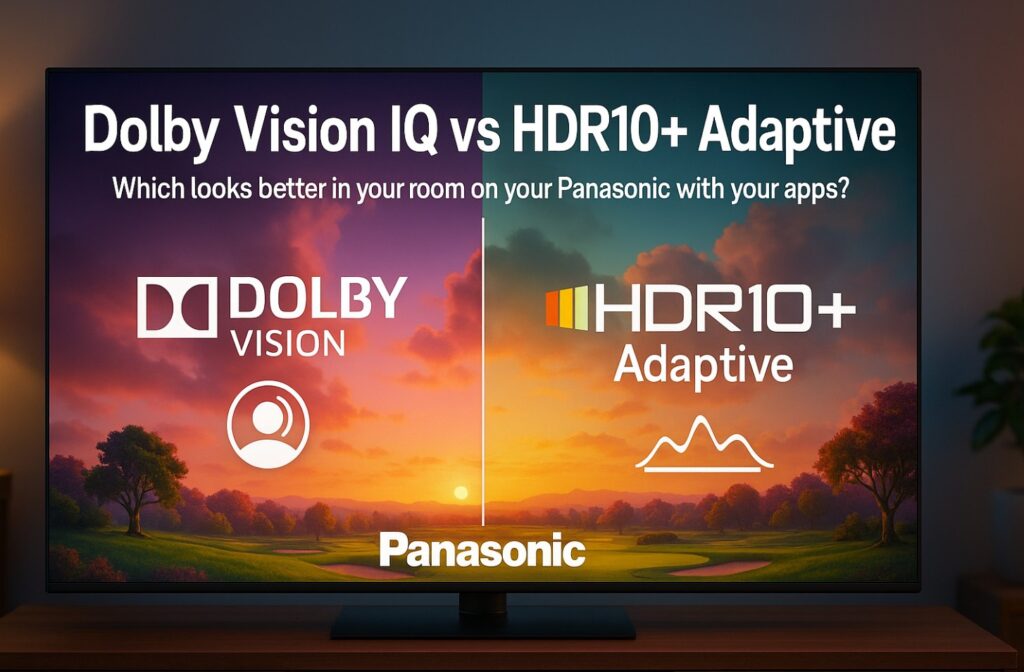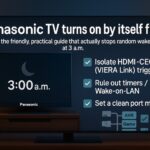Dolby Vision IQ vs HDR10+ Adaptive Panasonic is the question most owners ask after their first movie night: which mode truly looks better in your room, on your Panasonic, with your apps? Below you’ll get a practical answer—what to pick in bright sunlight vs dark cinema, how to set it on Fire TV–based Panasonics and on My Home Screen models, and what to do when a title doesn’t support your preferred format. 🌞🎬
In one line: Use Dolby Vision IQ when a title and app support Dolby Vision and you watch in mixed/bright light; use HDR10+ Adaptive when the title is HDR10+ or when DV isn’t available. In a fully dark room, prefer the non-adaptive “Dark/Reference” variant of each for the most accurate EOTF. 🙂
The core differences you’ll see (not just specs)
| What you care about | Dolby Vision IQ (Panasonic) | HDR10+ Adaptive (Panasonic) | What to choose |
|---|---|---|---|
| Bright room detail | Uses ambient sensor to lift near-black subtly while preserving highlight control | Also uses ambient sensor; tends to keep HDR10 look with smart exposure | Either is fine — pick the format your title actually has |
| Dark room accuracy | Dolby Vision Dark maps closest to reference in a dim cinema setup | HDR10/HDR10+ (non-Adaptive) tracks well if the mastering is clean | Prefer the non-adaptive version in a dark room |
| App/title coverage | Very strong on major streamers; some titles are DV-only | Strong on services that carry HDR10+; some titles are HDR10+-only | Match the title to avoid conversion compromises |
| Tone-mapping “feel” | Tends to preserve specular highlights and skin tones gracefully | Tends to keep a slightly more “HDR10-like” contrast curve | Go with what the title offers natively |
📝 Both modes read room light via sensors; both aim to keep shadow detail visible in daylight without turning the image “washed out.”
Best-practice presets for real rooms
A. Bright living room (daytime, blinds open) ☀️
- Choose: Dolby Vision IQ when available; else HDR10+ Adaptive.
- Picture Mode: Start from Filmmaker/True Cinema (DV IQ or HDR10+ Adaptive variant).
- HDR Brightness: +1 max if faces look too dim at noon; avoid pushing highlights into clipping.
- Noise Reduction / Edge Enhancement: Low/Off for 4K; avoid smearing texture.
- Motion: Low for sports; Off/Min for films.
- Energy Saving: Low (or Off while testing).
- Why: The ambient sensor lifts only what you need so text and faces don’t disappear in glare. 🙂
B. Mixed light (evening lamp, not pitch-black) 🌆
- Choose: Prefer Dolby Vision IQ first; if the title/app is HDR10+, HDR10+ Adaptive is great.
- HDR Brightness: 0; rely on the adaptive curve.
- Color: Keep enhancements off; skin tones stay natural.
- Why: You keep detail without losing the HDR “pop.”
C. Dark, cinema-like room (films) 🌙
- Choose: Dolby Vision Dark for DV titles; plain HDR10/HDR10+ (non-Adaptive) for HDR10+ titles.
- Gamma/EOTF: Reference; turn off ambient/AI light boosts.
- Why: Adaptive modes can over-brighten blacks in a dark theater and break artistic intent.
How to set it on Panasonic TVs
Menu paths can differ by model and OS. Panasonic sells TVs with My Home Screen (many regions) and with Fire TV OS (select 2024/2025 models). Follow your platform below.
Panasonic with Fire TV OS
- Open the streaming app (e.g., Disney+, Prime).
- Ensure Display > Dynamic Range = Adaptive/Always HDR (Fire TV menu).
- In the app/title that supports Dolby Vision, the TV will expose Dolby Vision IQ; if the title is HDR10+, you’ll see HDR10+ Adaptive.
- In TV Picture settings, start from Filmmaker/True Cinema and confirm Ambient/Intelligent Sensing = On for IQ/Adaptive; Off if using DV Dark or non-Adaptive HDR at night.
- For audio, keep eARC On and Digital Audio = Passthrough/Auto (for Atmos soundbars/AVRs). 🎧
Panasonic with My Home Screen
- Update TV firmware (Support/Network > Software Update).
- Launch your streaming app and play an HDR title.
- When the info banner shows Dolby Vision or HDR10+, open Picture and select the corresponding IQ/Adaptive variant for bright viewing.
- For a dark room, switch to Dolby Vision Dark or non-Adaptive HDR10/HDR10+.
What to do when the title doesn’t support your preferred format
- If a film is DV-only, use DV IQ in bright spaces or DV Dark at night.
- If a film is HDR10+-only, use HDR10+ Adaptive in bright spaces or HDR10+ at night.
- If it’s plain HDR10, pick your favorite accurate mode (Filmmaker/True Cinema), and leave the room sensor off in a dark room to avoid “flat” mids.
👉 In short: don’t force conversions. Choose the native format the title offers, then pick IQ/Adaptive (bright) or Dark/non-Adaptive (dark).
Common mistakes to avoid ⚠️
- Using Vivid and thinking “brighter = better.” It often clips highlights and nukes color accuracy.
- Leaving adaptive modes enabled in a blackout room—you’ll elevate blacks and lose “cinema” contrast.
- Overusing Noise Reduction/Sharpness; it wipes real film grain and facial texture.
- Ignoring app updates; some format flags are fixed by app/firmware updates, not just TV settings. 🙂
Quick “symptom → fix” table
| You see this… | Try this |
|---|---|
| DV/HDR looks too dim at noon | Switch to DV IQ or HDR10+ Adaptive; if still dim, HDR Brightness +1 only |
| Blacks look milky at night | Use DV Dark or HDR10/HDR10+ (non-Adaptive) and disable ambient light features |
| Specular highlights blow out | Drop Contrast a notch; keep HDR Brightness 0; avoid Vivid |
| Faces look plastic | Set Noise Reduction = Off/Low; Sharpness = 0–10 (brand baseline) |
| Motion looks soap-opera | Turn Motion/IFC to Off/Min for films; raise only for live sports |
FAQ
What is the best choice in bright rooms: Dolby Vision IQ or HDR10+ Adaptive on Panasonic?
Both work well; use the native format of the title. If it’s a DV title, choose Dolby Vision IQ; if it’s HDR10+, choose HDR10+ Adaptive. Both keep shadow detail visible in sunlight.
Does Dolby Vision IQ hurt accuracy at night?
In a dark room, the Dark/non-Adaptive variant is usually more accurate. Adaptive modes can lift blacks a bit when the room is pitch-black.
How do I stop HDR looking “flat” on Panasonic?
Avoid Vivid; use accurate modes (Filmmaker/True Cinema), turn off aggressive noise reduction, and pick IQ/Adaptive only in bright spaces.
Can I mix formats (e.g., force HDR10+ on a DV title)?
Don’t. Match the title’s native format and then choose IQ/Adaptive for bright or Dark/non-Adaptive for dark rooms.
Where do I enable/disable the room sensor behavior?
In Picture settings: the IQ/Adaptive variants use the sensor. For dark rooms, use DV Dark or non-Adaptive HDR modes and turn ambient adjustments off.
Final Verdict
For Panasonic owners, the smart, reliable rule is simple: follow the title’s native HDR format, then choose IQ/Adaptive for sunlit spaces and Dark/non-Adaptive for cinema nights. Set it once, enjoy the right detail at any hour, and keep your picture natural—no blown highlights, no crushed shadows, no plastic faces. 🌟🍿


